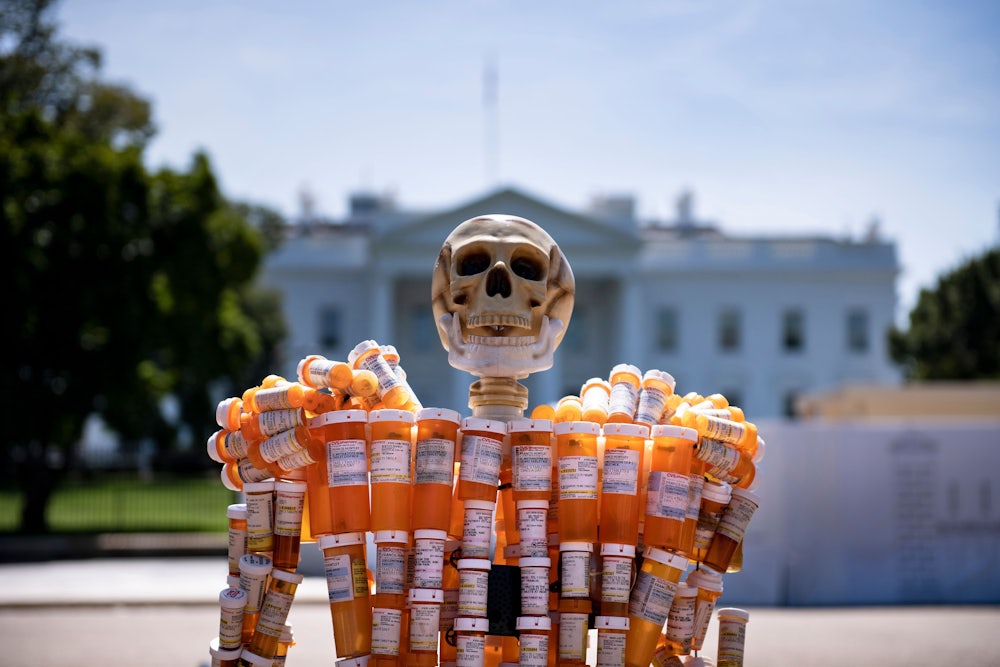In a sizable executive order released earlier this month, President Joe Biden asserted his determination to rein in prescription drug prices, higher in the United States than anywhere else on earth. The directives included measures intended to boost competition between insurers, ease generic drug entry into the market, and more. But one dictate received special attention from commentators: the continuation of a Trump-era shift toward facilitating large-scale drug importation from Canada, with Biden instructing the Food and Drug Administration to work with states to implement appropriate plans.
Drug importation has long been a popular and unusually bipartisan idea for providing relief from pharmaceutical price-gouging. Lawmakers as politically diverse as Bernie Sanders, Barack Obama, and Donald Trump have all championed the scheme, and 78 percent of Americans support it. For those rightfully outraged by the fact that peer countries pay an average of 56 percent of what the U.S. pays for any given drug, the prospect of routing our supply through our northern neighbor seems like a no-brainer. As David Sirota wrote at The Daily Poster before the signing of the executive order, by pushing drug importation forward, “the Biden administration is in the position to deliver a big win to begin saving consumers billions of dollars.” Florida Governor Ron DeSantis, frequently floated as a 2024 presidential candidate, welcomed the executive order (without exactly giving Biden any credit) and is awaiting approval of his state’s importation proposal.
But drug importation has never actually been as promising as it sounds. Even the most optimistic estimates offered by its loudest proponents amount to a barely perceptible dip in overall spending, and its ability to deliver even that depends on the willing participation of stakeholders who have already expressed extreme distaste for the measure. Even more, the plan’s drawbacks mirror those of other drug pricing reforms: They ultimately may not do much to help the people who need it.
Beginning in 2019, activists for insulin access began taking “Caravans to Canada,” where they could buy insulin and other diabetes supplies for as low as one-tenth the list price at U.S. pharmacies. For individual patients who would otherwise pay the cash price for a vial of insulin—the uninsured, or those who are insured but haven’t yet hit their deductible—it makes sense to source necessary drugs from Canada or through international online pharmacies. It also makes for powerful political theater: The journeys attracted widespread media attention, and included not only journalists but major politicians like Bernie Sanders, who’d accompanied patients on similar trips across the border while serving in the House of Representatives in the 1990s. Nicole Smith-Holt, whose diabetic son, Alec, died in 2017 when he aged out of her insurance and couldn’t afford his insulin, told me in 2019 how overcome she was to buy a vial in her son’s honor two years ago for a price that would have kept him alive.
But larger-scale importation is a heavier lift than individual trips across the border. Not only do rules allowing importation bar biologic drugs like insulin, they demand complicated administrative moves, like contracting with private wholesalers to negotiate with Canadian counterparts. Even more of a problem is the fact that importation depends on the consensual participation of two players who hate the idea: drug manufacturers and Canadian officials. The former are unlikely to agree to ship a much larger supply to Canada that they know will be sold southward for cheap to undercut profits in their most lucrative market, and the latter have already publicly stated they won’t compromise their own supply by overpromising exports to a nation 10 times Canada’s size. Importation is a sort of workaround, rather than a legitimate confrontation with industry power or flexing of regulatory muscle, so there are few mechanisms to combat these very obvious problems. For all of these reasons, DeSantis projects his state importation plan could save from $80 million to $150 million per year—a slim shaving off the state’s $44 billion health care budget.
An even more fundamental issue with drug importation as a solution to the drug pricing crisis is what it represents: There is nothing magical about Canada’s drugs relative to our own. Their pills are not made more efficiently or with cheaper materials. They’re identical to anything you could buy in any pharmacy in the U.S., except that they’re subject to the robust price controls of a single-payer health care system. We may as well import Canada’s entire Parliament.
But as different as the U.S. and Canadian health care systems are, an important similarity gets at the problem with legislators’ obsession with “fixing drug prices” in a vacuum: Neither country guarantees universal drug coverage, leaving two out of five Canadian patients struggling to afford their medicines, even with the benefit of a coherent regulatory structure. The reason that skyrocketing drug prices are such an urgent and unifying issue for patients is because they feel those prices when they’re at the pharmacy register and get understandably upset at the eye-popping bill. But that experience isn’t just an indictment of pharmaceutical greed: It also reflects woefully inadequate insurance coverage, a problem that drug pricing reforms in themselves can’t solve. And while Democrats in Congress remain ostensibly committed to drug pricing reform, it’s unclear how a reduction in overall spending would translate into savings for individual patients.
Such is the problem with a laser focus on drug pricing reform short of something like full-on public manufacture: Cutting the price of a $10,000 drug in half would be a legislative victory but could leave a patient struggling just as much to pay a $1,500 deductible and would be just as out of reach for most uninsured people. While the change could be felt by someone taking less expensive drugs, abundant research tells us that any out-of-pocket costs result in skipped care—and more and more drugs each year are priced so high that their costs would have to be reduced by almost 100 percent to make them genuinely affordable. Nor can any given entity cut cost-sharing across the board: While Medicare has alleviated the notorious “donut hole” problem for enrollees and cut out-of-pocket spending for certain prescription drugs, and many states have introduced co-pay caps for drugs like insulin in state-regulated private insurance plans, our piecemeal health care financing system guarantees patients will remain exposed to high drug costs.
That pain will only be alleviated by universal coverage without cost-sharing, without which even the allegedly affordable Canadian drugs remain out of reach for millions of Canadians, let alone their southern neighbors. Until that changes, drug pricing reform will help insurers and public payers by reducing overall spending, but patients will still get hit too hard at the pharmacy counter to feel it.




